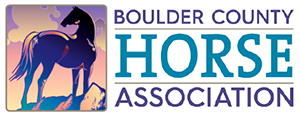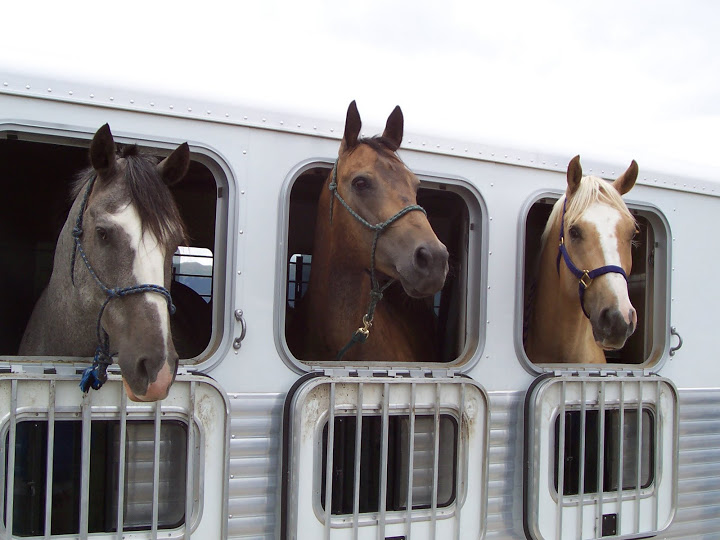By Suzanne Webel
After almost 40 years of driving a horse trailer on our mountain roads I hardly ever give it a thought any more. But the other day, when I suggested to a riding partner that we meet at the top of Flagstaff Road and she demurred, it occurred to me that an essay on “Driving a Horse Trailer on Mountain Roads” was long overdue. And then I thought, heck – why not also compile a bunch of ideas about safe driving “In Other Adverse Conditions.” So here are some tips gleaned from my own experience and that of a few other folks. The disclaimer: I am not a professional, and I am not an attorney. Drive at your own risk. Know your rig and its limitations, and have it checked frequently by a qualified mechanic. Don’t drive alone, unless you know where you’re going. Let someone else know where you’re going and when you estimate you’ll be back. When in doubt, just don’t do it. But if you decide to go for it, enjoy the ride.
Plan Ahead
Defensive driving requires all drivers to plan and to think ahead. As the driver of a large rig, you must be continually aware of the other traffic around you, because you will need to make wide turns, you will be driving more slowly than others, braking takes longer, and you need more space in traffic. Try to avoid narrow roads during rush hour traffic. If you are driving in an unfamiliar area, ask someone (possibly a passenger) to help you with directions, and always have a map of the area. If you are driving by yourself and need to get your bearings, pull off the road at a safe place and stop completely before looking at the map.
If I learn of a new trail that I want to check out, but I’m not sure if there will be room to park my trailer or whether the road will be passable for my rig, I always drive there first in my car, and I do the reconnaissance with my mental specifications of what it will be like to drive a trailer later.
Be Prepared
Listen to the local radio stations where you are traveling. Be aware of traffic slow downs, accidents, or road construction. If you are prepared and have a map, you may be able to take an alternative route to avoid unanticipated circumstances.
Weather Conditions
If you are driving in areas with possible adverse weather, obtain information first at local airports, highway patrols, state police, or ranger stations. Sometimes highway signs will show radio frequencies for weather information.
Crosswinds are the greatest threat because they can quickly push a vehicle and trailer combination into another lane, off the road completely, or into oncoming traffic. In most cases, slowing down is the best defense against strong winds. You may want to pull over and wait for the worst of the gusts to pass. If the trailer starts to sway, gradually apply the trailer brakes; don’t let the swaying get worse. Headwinds require a lower gear to maintain usual speeds.
Always carry truck and trailer chains when you travel in snow country. Know how to put them on. Chains are needed for both the tow vehicle and for one axle of a trailer.
If you are towing a trailer on icy roads, go even more slowly than you think necessary, especially downhill. Use the truck’s lower gears to avoid braking if possible. If the ice is patchy, try to brake in the dry stretches before you enter a snowy or icy patch.
Rain can cause slick driving conditions, especially if it hasn’t rained for a long time. Be aware of the possibility of hydroplaning, and apply your brakes gently to avoid it.
Always carry a set of jumper cables, a towing chain, and a blanket.
Starting, Shifting, and Braking
Always try to start and shift (for manual transmissions) smoothly to prevent wear and tear on the hitch and transmission systems, and to provide a smoother experience for your horses.
Even if you have an automatic transmission, you should override it on mountain roads by downshifting through your gears to accommodate the road grades, uphill and down.
If you have an Allison Transmission, tap the brake gently when you reach your desired speed on a downhill grade, and the transmission will shift itself into whatever gear is necessary to maintain that speed.
Gravity wins every time. Just about any grade up a hill will cause you to slow down. The steeper the grade, or the longer the grade, or the heavier the load, the more you will have to use lower gears to climb hills or mountains. Do not drive in the fast lanes on a multiple-lane grade. Stay in the far right lane while climbing a steep grade if your rig won’t maintain the legal speed limit. It’s better to drop to a lower gear and slow down rather than pass slow trucks and tie up the faster lanes because you don’t have enough power.
When going down steep hills, gravity will tend to speed you up. Select an appropriate safe speed, then use a low gear and enough braking power to hold you back without letting the brakes get too hot. Use your truck’s lower gears to provide most of the braking necessary to control your speed. Save your brakes so you will be able to slow or stop as required by road and traffic conditions. Slow the vehicle and shift the transmission to a low gear before starting down a grade.
Once your vehicle is in the proper low gear, apply the brakes just hard enough to feel a definite slowdown. When your speed has been reduced to approximately five mph below your “safe” speed, release the brakes (this brake application should last for about three seconds). When your speed has increased to your “safe” speed, repeat the steps above until you have left the grade.
If you have used your brakes too much, they will let you know it by exuding that terrible stench of burning rubber. If that happens, your brakes are too hot. Stop driving completely and let your brakes cool off a bit. If you don’t, you can actually fry your brakes — leaving you with virtually no stopping power at the bottom of the hill. You may even begin to see smoke coming from your overheated brakes. Everyone knows, where there’s smoke there’s fire…. Don’t let it get to that point
Turning
A long wheel base makes it necessary to turn wider at intersections; if you turn too tightly, the rear wheel may roll over the curb (or a rock!). Go farther into the intersection before starting the turn than you would with a passenger car, and adjust your lane position to increase the turning radius.
Curves even in a highway can also be tricky. Stay more to the center of the lane for right turns and curves, so the rear wheels will not move off the pavement. For a left turn or curve, stay more to the right of the lane to prevent the back of the trailer from tracking into the adjacent land or into an oncoming lane of traffic.
Horse trailers (especially with animals inside) have a higher center of gravity than your truck. Turning corners and taking curves must be done at slower speeds to prevent swaying. Slow down before you enter the curve.
Horses that are not tied can move around in a trailer. This shifts the center of gravity and could make a rollover more likely. If possible, use dividers between each animal to let each horse keep its own balance, rather than bunching up. On curved roads, horses may lean into the curve and this could cause a rollover if you are driving too fast.
Practice “broken-Y turns” with your rig at home or in a quiet place before you set out on an adventure, so that you will be able to turn around calmly and efficiently if you get into a tight spot.
Narrow Roads
Be a good ambassador for equestrians: don’t hog the road! If you are driving more slowly than the rest of the traffic, pull over occasionally into special “turnout” areas to allow vehicles behind you to pass. When you drive a slow-moving vehicle on a two-lane highway or road where passing is unsafe, and five or more vehicles are following you, pull to the side of the road wherever you can safely do so to let the other vehicles pass.
Try to stay to the right of your lane so the vehicles behind you can see ahead. Let them know it is safe to pass you by waving them by, or by putting your right turn signal on briefly.
If you find yourself on a “shelf road” (one that hugs the side of a cliff), stay to the inside as much as possible regardless of whether you are going uphill or down. If there are oncoming vehicles, use common sense as to who should have the right of way and who should yield it.
If you develop acrophobia, take a deep breath and focus on the road ahead or on the side of the hill just above you. Don’t look down.
Dirt or Unpaved Roads
There’s no reason to avoid dirt roads, but there are some techniques that will result in a safer and more comfortable ride than others.
Don’t get going too fast, because you might encounter unexpected bumps, washboarding, or rocks, and you may not be able to slow down in time to avoid them.
Don’t use your brakes too hard or “washboarding” of the road will result. If you encounter a washboarded section, slow down. Don’t let the “harmonic frequency” of the washboard increase or it will cause dangerous interactions with the road and your rig.
Pay close attention to the signs posted and believe them. If a sign prohibits trailers, don’t use that road. There may be a hazard such as rocks, low trees, or washed-out sections of the road ahead, or no place to turn around in an emergency.
Mountain Roads
Some mountain roads have very tight switchbacks. See diagram for how to negotiate a mountain switchback. Be sure to check oncoming traffic before making these maneuvers.
If you are climbing up a switchback to the right, downshift and take your truck a bit wide to the left before you enter the switchback, then swing right – or you may find yourself “high-centered” in the curve with no way to go forward. If you are descending a switchback to the right, swing a bit wide left first, then right around the turn. Take them slowly, downshifting before the switchback and adding gradual braking as needed to prevent unwanted acceleration.
If you get into really tough going, put your truck into 4WD, down to “granny gear” or 4L if you have it.
Once when I was working my way up a road that was too steep for my rig, I got too close to the inside of a switchback, I ran out of low gears, and my wheels started to spin, even with 4WD. I realized I just wasn’t going to make it… So I stopped in the middle of the switchback, unloaded the horses to lighten the load, tied them to a tree, ran back to the truck, drove it up the rest of the hill, parked it off to the side, ran back down to the horses, untied them and led them all the way back up the hill to where my rig was, loaded them back in, and drove on my way. Now that’s desperate – but desperate situations call for desperate solutions.
Happy Trails, and “Happy Roads” to get you there.

